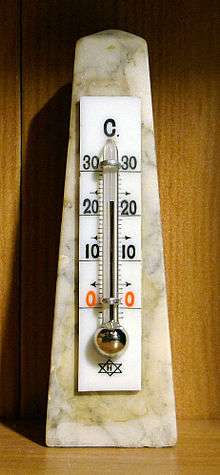Room temperature

Colloquially, room temperature refers to a range of temperatures that people tend to prefer for indoor settings, at which the air feels neither hot nor cold when wearing typical indoor clothing. The range is approximately between 15 °C (59 °F) and 30 °C (86 °F)[1] and various methods of climate control are often employed to maintain this thermal comfort level. In certain fields, like science and engineering, and within a particular context, "room temperature" may have an agreed upon value for temperature.
Comfort levels
The American Heritage Dictionary of the English Language identifies room temperature as around 20 to 22 °C (68 to 72 °F).[2]
Owing to variations in humidity and likely clothing, recommendations for summer and winter may vary; a suggested typical range for summer is 23 °C (73 °F) to 25.5 °C (78 °F), with that for winter being 20 °C (68 °F) to 23.5 °C (74 °F).[3] Although by other considerations the maximum should be below 24 °C (75 °F) – and for sick building syndrome avoidance, below 22 °C (72 °F).[3]
According to the West Midlands Public Health Observatory (UK),[4] an adequate level of wintertime warmth is 21 °C (70 °F) for a living room, and a minimum of 18 °C (64 °F) for other occupied rooms, giving 24 °C (75 °F) as a maximum comfortable room temperature for sedentary adults.[5] At temperatures below 20 °C (68 °F), increased risk of death and shortened life expectancy has been observed, and winter deaths reportedly rise at a rate of about 1.4% per degree below 18 °C (64 °F).[5]
Ambient versus room temperature
Room temperature implies a temperature inside a temperature-controlled building. Ambient temperature simply means "the temperature of the surroundings" and will be the same as room temperature indoors. In many languages, such as Spanish, Portuguese and Italian, there is an expression for ambient temperature, but no distinct translation for room temperature.[6]
See also
References
- ↑ Merriam Webster's Medical Dictionary. 2016.
- ↑ The American Heritage Dictionary of the English Language (5th ed.). 2014.
- 1 2 Burroughs, H. E.; Hansen, Shirley (2011). Managing Indoor Air Quality. Fairmont Press. pp. 149–151. Retrieved 25 December 2014.
- ↑ Hartley, Anne (1 March 2006). "Fuel Poverty". West Midlands Public Health Observatory. Birmingham, UK: West Midlands Public Health Observatory. Retrieved 25 December 2011.
- 1 2 Roberts, Michelle (27 October 2006). "Why more people die in the winter". BBC News. Retrieved 25 December 2011.
- ↑ "ambiente". WordReference.com Spanish-English Dictionary. WordReference.com. Retrieved 20 September 2011.